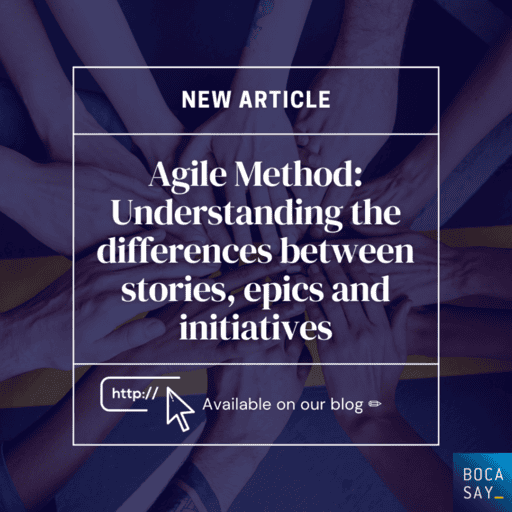Agile Method: Understanding the differences between stories, epics and initiatives
Agile methodology provides a flexible, adaptable, customer-centric, and collaborative approach to software development. Deploying an agile approach can lead to faster delivery of high-quality software products that can meet evolving customer needs.
First and foremost, the agile development approach is based on the principles of flexibility and adaptability. This means that it is an approach specifically designed to handle changes and respond quickly to changing requirements or customer needs. In addition, it enables IT teams around the world to adjust their work based on feedback from stakeholders, which leads to better collaboration, more efficient development, cost-reduction and faster delivery of robust software solutions.
In this article, Bocasay, our offshore outsourcing company, begins with the basics and provides an overview of 3 key terms used within the agile software development approach: stories, epics and initiatives.

What is Agile Methodology in Software Development?
Within the software development industry, the agile approach refers to a methodology that emphasizes:
- Iterative and incremental development.
- Continuous delivery.
- Close collaboration between stakeholders, developers and customers.
The method is based on the Agile Manifesto, a set of principles for software development that prioritizes individuals and interactions, working software, customer collaboration and a fast response to change.
The Agile method offers a wide range of advantages for software development projects:
- Continuous Delivery: Emphasizing the continuous delivery of functioning software, the agile method basically develops software in small increments and delivers results frequently, often at the end of each development iteration.
This enables your IT team to receive early feedback, to perform adjustments as necessary, and to reduce the risk of developing a product that does not meet the customer’s needs.
- Collaboration and Communication: The agile methodology promotes collaboration and communication between team members, stakeholders, and customers. It encourages face-to-face conversations and encourages everyone to work together towards a shared goal – leading to better teamwork, faster decision-making, and a more cohesive software development process.
- Customer-Centric Approach: Established around the idea of making the customer’s needs your top priority, the agile methodology emphasizes the importance of understanding customer requirements while continuously testing and validating the product to ensure that it meets those requirements.
- Predictability: Finally, the agile method provides a high degree of predictability within software development projects. It breaks down complex projects into smaller, manageable parts and establishes a predictable path of delivery.
This helps stakeholders to better understand what is being developed and when it will be delivered.
𝕐𝕠𝕦 𝕨𝕒𝕟𝕥 𝕥𝕠 𝕚𝕟𝕔𝕝𝕦𝕕𝕖 𝕞𝕠𝕣𝕖 𝕒𝕘𝕚𝕝𝕚𝕥𝕪 𝕚𝕟 𝕪𝕠𝕦𝕣 𝕀𝕋 𝕕𝕖𝕧𝕖𝕝𝕠𝕡𝕞𝕖𝕟𝕥 𝕡𝕣𝕠𝕛𝕖𝕔𝕥𝕤? 𝔹𝕠𝕔𝕒𝕤𝕒𝕪 𝕠𝕗𝕗𝕤𝕙𝕠𝕣𝕖 𝕠𝕦𝕥𝕤𝕠𝕦𝕣𝕔𝕚𝕟𝕘 𝕔𝕠𝕞𝕡𝕒𝕟𝕪 𝕚𝕤 𝕙𝕖𝕣𝕖 𝕗𝕠𝕣 𝕪𝕠𝕦. 𝔻𝕚𝕤𝕔𝕠𝕧𝕖𝕣 𝕠𝕦𝕣 𝕥𝕒𝕝𝕖𝕟𝕥𝕖𝕕 𝕔𝕠𝕝𝕝𝕒𝕓𝕠𝕣𝕒𝕥𝕠𝕣𝕤 𝕒𝕟𝕕 𝕝𝕖𝕥’𝕤 𝕒𝕕𝕠𝕡𝕥 𝔸𝕘𝕚𝕝𝕖 𝕞𝕖𝕥𝕙𝕠𝕕𝕤 𝕥𝕠𝕘𝕖𝕥𝕙𝕖𝕣. 𝕐𝕠𝕦 𝕙𝕒𝕧𝕖 𝕒 𝕢𝕦𝕖𝕤𝕥𝕚𝕠𝕟? 𝕀𝕥’𝕤 𝕠𝕧𝕖𝕣 𝕙𝕖𝕣𝕖!
Understanding Key Terms: Stories, Epics and Initiatives
In Agile methodology, “stories,” “epics,” and “initiatives” are terms used to describe different levels of requirements or features that need to be developed within a software development project.
Stories
Stories are the smallest unit of requirements in agile methodology. They represent a user or customer need that can be implemented in a single development iteration.
Within an agile team, stories are a task that can typically be performed within one or two-week sprints. A story will often consist of a short description of the requirement, acceptance criteria and priority.
Examples of stories can include the following:
“As a user, I want to be able to search for products by name”
“As a customer, I want to be able to track my order status.”
“As a user, I want a ‘like’ button under each video.”
“As a customer, I want to be able to write a product review.”
Epics
Epics refer to larger units of requirements that cannot be implemented in a single development iteration.
They are usually a collection of related stories that together form a bigger user need, or ‘theme’ of requirements. Epics are typically divided into smaller stories and prioritized based on business value.
Examples of epics can include the following:
“Improve website performance.”
“Add a new payment method.”
“Optimize customer support services.”
“Speed-up video streaming platform.”

Initiatives
When using the agile method, initiatives form the highest level of a software project’s requirements. They represent a strategic goal or objective that the development team is working towards.
An initiative may consist of multiple epics, stories, and other requirements, and it usually spans several months or even years.
Examples of initiatives can include the following:
“Improve customer engagement.”
“Expand into new markets.”
“Establish brand visibility on all major social media platforms.”
“Expand the range of financial services provided.”
Conclusion
In summary, stories represent individual user or customer needs, epics are collections of related stories, and initiatives are strategic objectives that guide the development of multiple epics and stories.
Within agile development, all three levels of requirements are used to help software development teams to prioritize and plan their work faster and more efficiently.